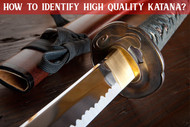How to Identify a High-Quality Katana?
Posted by SwordsSwords on Sep 2nd 2023
Katanas were the iconic samurai swords in bygone eras of Japanese history. The ancient techniques used to forge katana swords in feudal Japan have been lost, making it very difficult to match their high quality today.
Sadly, many collectors today placate themselves with imitations. However, true katana aficionados and martial art practitioners still look for authentic blades.
There are many copies of the original sword in the market, claiming to be real. The accurate judgment of quality katanas is a must before investing in an expensive blade.
There's tons of information online about figuring out how good an old Japanese sword is. But really, all it takes is a close look at a few important things.
You need to carefully check out the shape of the blade, what it's made of, any markings on it, and how worn down it's gotten. If you pay attention to the details instead of over-researching, you can tell the difference between a well-made sword that lasted centuries and a cheaper imitation.
Here’s how to do that:
Steel
The quality of the steel used is one of the most critical factors when considering a katana. The type and grade of stainless steel is especially important, as some varieties are better suited than others for a functional blade.
While ferritic stainless steels may be acceptable for decorative katanas due to their corrosion resistance, professionals would likely prefer blades forged from high carbon steel or higher-grade austenitic stainless steels.
These alloys offer the strength and edge retention needed in a sword that will be regularly handled. Forged carbon steel remains the traditional material that allows for superior craftsmanship, as evidenced by katanas of centuries past.
When searching for a high quality katana, capable of light practice cuts, inquire about the specific stainless steel used - ideally an austenitic grade with excellent toughness and durability. A blade forged from the right alloy is key to getting a quality katana.
Angle
The angle and curvature of the blade are important factors when evaluating katana quality. An ideal Japanese sword features a gently curved single-edged blade that tapers to a thin and sharp tip.
The angle of the cutting edge and the degree of curvature along the blade are precisely measured during forging to achieve the perfect balance and cutting ability. A well-crafted katana will exhibit an arc of approximately 15 degrees along the back edge near the hilt, gradually straightening towards the tip for effective slicing motions.
The tip itself is ground to an angle between 10 to 15 degrees while maintaining structural integrity. Even minor deviations from these optimal blade angles can negatively impact performance.
Quality
Tests
A paper cutting test is the most appropriate test to check the quality of the katana. The blade must slice a thin piece of paper held vertically. This test is used to judge if the blade is razor sharp, the flexibility of steel, and the balance of the sword. A perfect cut in the paper is symbolic of the perfect blade form.
Blade Polishing
Properly polishing the blade can help reveal any hidden flaws in the katana's construction or forging. The back edge and sides of the blade should be carefully polished until these surfaces shine brightly, with no signs of dull, flaking layers.
In times past, taking the time to polish a katana in this manner would allow the beautiful patterns forged into the steel during construction to emerge. These intricate patterns were a hallmark of the skilled smith's craft.
Modern mass production techniques have largely replaced traditional forging methods. As such, most swords today receive only a basic foundation polish rather than a thorough polishing that fully brings out the subtle details of the steel. The highest quality katana that has been meticulously polished according to ancient techniques will stand out in terms when compared to a superficial blade.
Price and Authentication
Beware of the outlets selling cheap blades with the label “genuine samurai swords”. More often than not, a quality katana will be a sizeable investment.
If you are a true collector of samurai swords and respect the traditional Japanese sword making art, be sure to check out our selection of high quality blades at swordswordswords.com.

